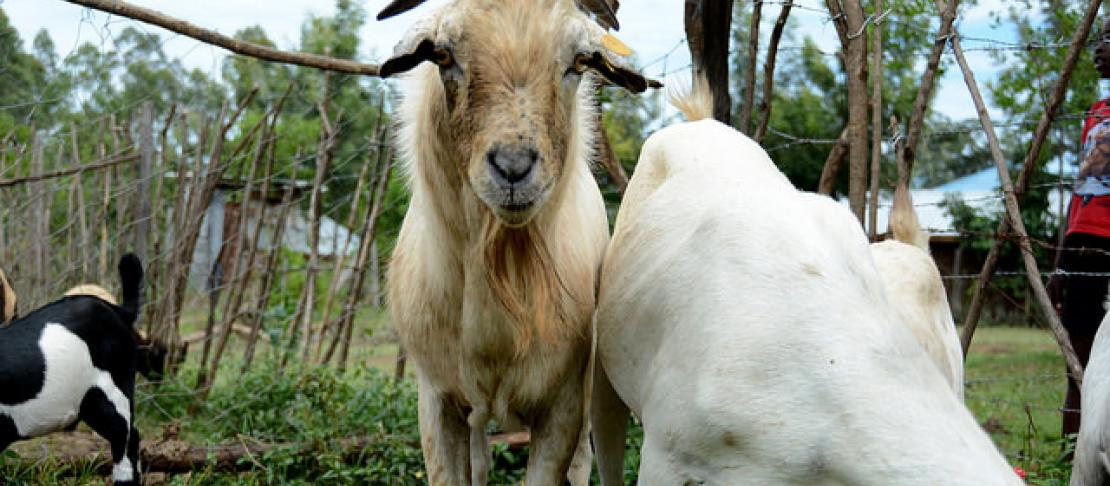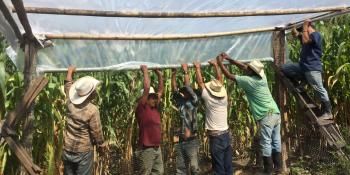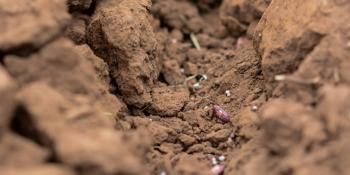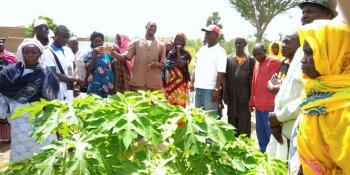Building the capacity of farmers in small ruminant management for climate change adaptation and mitigation

Training on record keeping, objective measures for animal selection and controlled mating helps farmers manage improved breeds and thereby increase food security.
Compared to local breeds, the crosses of the Red Maasai sheep and Galla goat are better able to withstand heat stress and to recover from drought, utilize poor forage and cope with diseases, and are able to attain mature market weights within shorter periods of time. The Red Maasai sheep have longer and large tails, which we prefer for our cultural ceremonies.” Joshua Omollo, champion farmer
Smallholder farmers in Nyando Climate-Smart Villages (CSVs) in western Kenya are testing a portfolio of agricultural interventions that respond to climate-related risks they face. One such intervention is the introduction of improved breeds of indigenous sheep and goats (collectively called small ruminants) in a bid to improve the productivity of the local Small East African sheep and goats. The small ruminants are important in ensuring food security under a changing climate as they provide households with both nutrition and disposable income. Their small body size, flexible feeding habits and short generation intervals make them suited to climate risk management. Their low investment costs are affordable to the subsistence farmers, and are often owned and tended by women and children. The improved breeds of Red Maasai sheep and Galla goats are crossed with the local breeds for resilience.
In order to build the capacity of farmers for improved small ruminant breeding and management, the International Livestock Research Institute (ILRI) undertakes regular, demand driven training. One such training event took place from 27 to 29 September 2017. The training focused on improved small ruminant management practices and brought together over 250 champion farmers from seven test villages. These champion farmers, were from the three umbrella Community-Based Organizations – FOKODEP, KAPSOKALE and NECODEP. The training covered record keeping, objective measures for animal selection and controlled mating.
Record keeping: Farmers were informed that this is useful in decisionmaking, keeping track of activities, production monitoring and documenting important events on the farm. The farmers were trained on the importance of weight records (birth weights, weaning weights and 9 months weight), animal health records, breeding records and pedigree records. The records are important for purposes of evaluating the economic benefit of the herd and to aid in selective breeding of the animals.
Objective measures for animal selection: In order to avoid subjective selection of animals for breeding, the farmers were taught the various objective measures for selecting animals. The farmers were taught how to estimate the age of a sheep or goat using its dentition. The use of the chest girth and body length measurements to estimate the weight of the sheep or goat was also demonstrated. Farmers were also taught how to select rams/bucks for breeding based on the observable characteristics of each animal resulting from the interaction of its genes with the environment. It was noted that the size and age of sheep and goats directly affects their productivity.
Controlled mating: The farmers were taken through an exercise of mapping the expected rainfall, lambing/kidding, and market demand across the twelve months of the year. Farmers were taught how to plan their mating depending on the seasons. It was emphasized that mating should be planned such that the animals give birth during the rainy season when there is enough pasture for the mothers to produce milk. This will ultimately promote good growth and survival rates. Farmers were taught how to use an apron that covers the male reproductive organs to prevent unwanted mating. The farmers were also urged to cull and/or sell the old rams or less productive animals instead of young potentially productive animals.
“In-breeding within the local Small East African sheep and goats in the Nyando area has resulted in more smaller animals that take long to mature and fetch poor market prices. The ILRI initiative has helped control in-breeding in the region, and the cross breeds are about one-third of the small ruminants in the villages,” said Monica Bett, a Livestock extension officer from Kericho County Department of Agriculture, Livestock and Fisheries.
Upscaling of the small ruminant intervention is being planned through partnership with the private sector, and County Departments of Agriculture and Livestock. The households own an average of five sheep and six goats, out of which one third are either cross breeds or improved breeds. It is hoped that the scaling-up process will address climate change mitigation, through farmer decisions to keep a small number of small ruminants, thereby reducing greenhouse gas emissions.
Read more:
- Nature article: Climate-adaptation effort cuts hunger in African villages
- NPR article: Heat Tolerant, Tough Teeth, Lots Of Milk - They're Supergoats!
- CCAFS blog: Nyando white goats: climate-resilient and a real-time fortune
- CCAFS blog: Diversifying fodder for improved livestock productivity in Nyando
Philip Kimeli, John Recha work at CCAFS East Africa. James Audho, Edwin Oyieng are Research Assistants in Livestock Breeding at ILRI.



